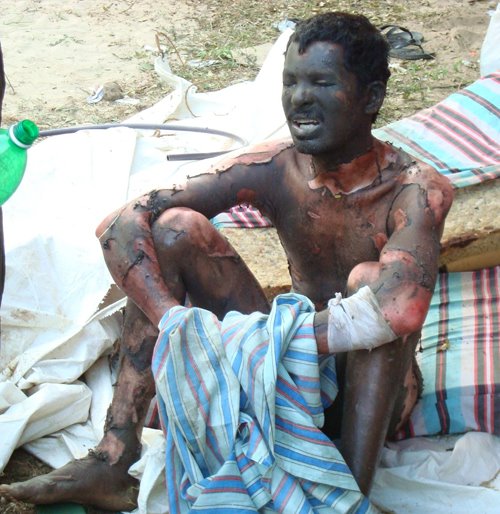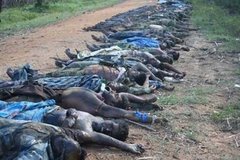Ilankai Tamil Sangam30th Year on the Web Association of Tamils of Sri Lanka in the USA |
||||||
 Home Home Archives Archives |
Sri Lanka Launches Gas Attacks on Tamil Civilians, and Tamils Prepare for Moreby Tamils for Obama, PRWeb, May 15, 2009
The Sri Lankan military has launched mustard gas attacks against Tamil civilians in the "safe zone." Tamils for Obama has prepared a list of procedures to follow in case of more poison gas attacks. War Without Witness and many other credible sources have given descriptions and evidence of attacks with chemical weapons by the Sri Lankan military. These attacks have been against Tamil civilians in the "safe zone" as well as combatants. [Eyewitness account here. Report on chemical weapon composition here.] War Without Witness made the report on April 5, 2009 on its website. War Without Witness reports that the chemical substances found in the wounds are Triethanolamine (C6H15NO3) and Phosgene (CCl2O) . A link to the website is available below. The Sri Lankan army delivers the poison gas by artillery shells and rockets, according to the report from War Without Witness. The gases it uses are "blistering agents" similar to mustard gas rather than nerve gases like those used by Saddam Hussein against the Kurds or used in the Tokyo subway attacks.
Tamils for Obama contacted Dr. Sujanthy Rajaram and asked her to prepare a list of precautions and procedures to be followed by likely victims of gas attacks. Her recommendations are specifically directed at mustard gases, the kind of poison used by the Sri Lankan army. The Tamil group has urged diaspora Tamils to share the list with friends and relatives in the war zone. A summary of Dr. Rajaram's procedures is below. War Without Witness Interviewed several victims. Some of the symptoms observed by the victims included high vomiting, mustard-colored blisters, closed throats, breathing difficulty, and extreme pain. There will probably be more chemical attacks before this war is over. Tamils for Obama asked Dr. Sujanthy Rajaram to suggest what the Tamil civilians should do in case of chemical attack on them. Here are some suggestions that she put forward for civilians living in the "safe zone." Her recommendations follow. 1. Use the following precautions: Avoid exposure as much as possible. Cover the whole body to avoid direct skin contact (use shoes, caps, body suits, gowns, rubber gloves, and masks) and eye contact (wear eye shields or protective glasses). 2. Decontamination is mandatory to prevent continued exposure to the agent. Medical personnel and helpers should wear chemical (butyl rubber) gloves during decontamination because latex gloves are not adequate.
3. Victims should remove clothing and any visible agent on the skin, and move to an area free of vapor hazards. Physical removal of the agent is important. It can be done by wiping off the agent with dry powders (such as flour, powdered soap, or dirt), showering, washing with soap and water, washing with 0.5% hypochlorite solution, or using resin decontaminants. 4. Eyes should be irrigated with water or saline 5. Victims should be admitted to the intensive care unit after the decontamination. One animal study suggests that rapid application of providone iodine ointment (iodine) within 20 minutes of exposure to mustard liquid may protect the skin from vesication (blistering). Use of barrier creams may prevent dermal toxicity. 6. Treat chemical burns in the hospital in ways that are similar to treatment of thermal burns: analgesia, infection control, and fluid replacement. Antibiotic ointments and silver sulfadiazine creams are recommended for topical burn care. Dermal hypersensitivity may respond to antihistamines or oral or systemic corticosteroids (steroids). All patients with ocular exposure should have contact lenses removed, and the eyes should be thoroughly rinsed with saline. Topical mydriatics (medication to dilate the eye), antibiotics, and limited steroids (12-24 hours) have been recommended. Mild respiratory exposure may respond to antitussives, warm humidified air, and bronchodilators (medication to relieve the spasm of the airway) for wheezing or bronchospasm. Persistent symptoms may suggest bronchitis, pneumonia, or pneumonitis, and will require more aggressive therapies. To read Dr. Rajaram's entire report and procedures go to: http://www.tamilsforobama.com/pressrelease/gas_attack_precautions.html
To see the War Without Witness report go to: http://www.warwithoutwitness.com/ Tamils are an ethnic group living mainly in the northeast of Sri Lanka and southern India. They are a minority population in Sri Lanka, and are currently bearing the brunt of a civil war they regard as genocide. One third of the Tamil population has fled the island and formed a substantial diaspora overseas. Tamils for Obama is comprised of Tamils who have settled in the U.S. or who were born in the U.S. To contact the group, call at (617) 765- 4394 and speak to, or leave a message for, the Communication Director, Tamils for Obama. ### |
|||||
|
||||||

